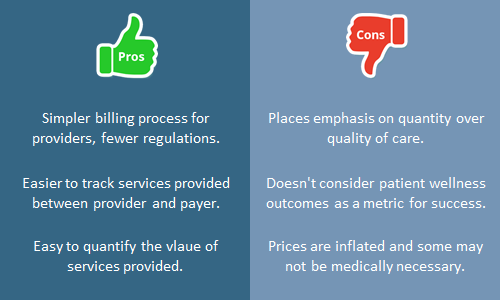Understanding different forms of reimbursement methodologies and their pros and cons can help you better figure out your organization’s revenue cycle management. The two main models we will cover are fee-for-service (FFS) and value-based care (VBC).
Fee-for-Service (FFS)
In this model, healthcare providers charge based on individual services rendered (i.e. appointments, treatments, tests ordered, surgeries performed, etc.) Each of these services has its own code and price, and the physician is reimbursed with a fee for each service, accordingly.
The reimbursement a provider receives depends on the patient’s insurance. Medicaid payment rates are the lowest, followed by Medicare and finally commercial insurance. A provider may receive 2-3 times as much reimbursement when providing the same service to a patient with private insurance compared to one with Medicaid.

Value-Based Care (VBC)
In this model, reimbursement is based on the quality of care provided. It bases bills on positive outcomes rather than individual services rendered, which also makes the option for bundling payments available. These are intended to encourage providers to deliver the best care at the lowest cost. In general, there are two types:
- Gain Share (or One-Sided Model), and
- Risk Share (or Two-Sided Model)
With a one-sided model, providers are rewarded when they perform well (desired outcomes). With a two-sided model, they are rewarded (or punished) depending on their outcomes.
Bundled Payments (or Episode-Based Payments)
Bundled payments take the cost of each service and combine it into one “episode-based” payment. Pricing for each service is based on historical prices. This method challenges providers to find better methods of providing efficient and quality care to their patients. If providers can find a way to save money and be efficient, they can keep the savings, but if the cost is higher than expected, they have to absorb the cost themselves.

This has been just a brief overview of two different payer reimbursement models; there are many variations of each that can impact the financial health of your practice. If you are having difficulty figuring out how you are being reimbursed for services, or other payer contracting issues, please contact CodeToolz today.




